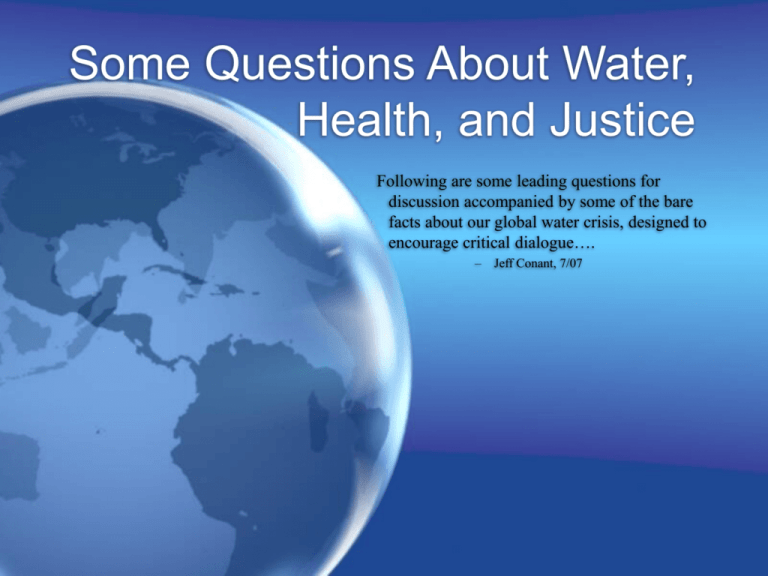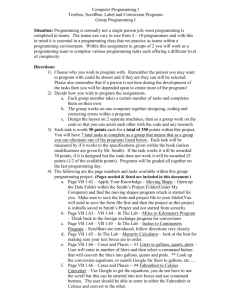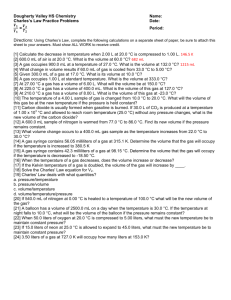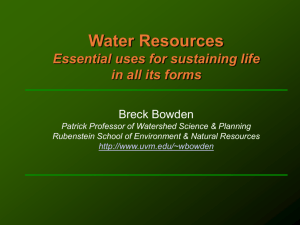WaterHealth(Conant_070710)
advertisement

Some Questions About Water, Health, and Justice Following are some leading questions for discussion accompanied by some of the bare facts about our global water crisis, designed to encourage critical dialogue…. – Jeff Conant, 7/07 Over 5 million people, mostly children, die annually due to preventable water-borne diseases. WHY? Water and health It’s a commonplace to say that water is essential to health. What are some of the ways that water, and the ways we use it, impact our health, either positively or negatively? What are some of the structures that exist that lead to waterrelated health problems? Some facts about structural inequalities in access to safe, sufficient water The minimum amount of water needed for drinking, cooking, bathing, and sanitation is 13 gallons (50 liters) (WHO figure) The average person in the United States uses between 65 to 78 gallons of water (250 to 300 liters) per day for drinking, cooking, bathing, and watering their yard. The average person in the Netherlands uses only 27 gallons (104 liters) per day for the same tasks. The average person in the African nation of Gambia uses only 1.17 gallons (4.5 liters) of water per day. 12 percent of the world's population uses 85 percent of its water Global consumption of water is doubling every 20 years, more than twice the rate of human population growth. Presently, 1.2 billion people lack access to improved water supply and 2.4 billion to improved sanitation -- i.e. one in six people still have no regular access to safe drinking water Lack of clean drinking water leads to nearly 250 million cases of water-related disease each year and between 5 and 10 million deaths. Three main causes of water contamination and water scarcity: - Water Pricing - Water Mining - Water Abuse Water pricing Problem: people cannot afford the prices being imposed by corporations that increasingly control water and water distribution systems. (I.e. the inversion of gravity as economic law: Water flows uphill towards money)… Some facts about water pricing: Poor people in the “developing” world pay on average 12 times more per liter of water than fellow citizens connected to municipal systems There are ten major corporate players now delivering fresh water services for profit. Between them, the three biggest -- Suez and Vivendi [recently renamed Veolia Environment] of France and RWE-AG of Germany -- deliver water and wastewater services to almost 300 million customers in over 100 countries. Although less than 10 percent of the world's water systems are currently under private control, at the rate private corporations are expanding, the top three alone will control over 70 percent of the water systems in Europe and North America in a decade. The World Bank has been the principle financer of privatization, lending about $20 billion to water supply projects over the last decade; the majority of World Bank loans for water in the last five years have required the conversion of public systems to private as a condition for the transaction. When Bolivia privatized their water systems, as a result of a World Bank initiative involving a Bechtel subsidiary, the price of water tripled. The government of South Africa has cut off water supplies to over 10 million people because they could not afford to pay for their newly privatized service -- despite a constitutional guarantee of access to water for all. Public Services International (PSI) reports that in England, between 1989 (the year water was privatized) and 1995, there was a 106 percent increase in the rate charged to customers, while the profits of the companies increased by 692 percent. As a result of these price hikes, the number of customers who have had their water disconnected has risen by 50 percent since privatization. Solution: - Democratic control over our water resources - Human right to water P.S: Water is not a problem…it’s always a solution (unless it’s a gas or a solid)…Get it? Water scarcity Problem: Decreasing drinkable water (the amount of water on earth is finite; only 1/2 of one percent of it is drinkable, and most of that is bound up in ice) (See also Mark Twain: “Whiskey’s for drinkin’ and water’s for fightin’ over…”) Some facts about water scarcity (keeping in mind that ‘scarcity’ is a concept from economics, not ecology…and may be considered a socially constructed “myth” to prevent us from seeing the real issue -- poor distribution of resources) The High Plains Ogallala aquifer, stretching 1,300 kilometers from the Texas panhandle to South Dakota, is being depleted eight times faster than nature can replenish it The water table under California's San Joaquin Valley has dropped nearly ten meters in some spots within the last 50 years. In the Arabian peninsula, groundwater use is nearly three times greater than recharge and, at the current rate of extraction, Saudi Arabia is running toward total depletion in the next 50 years. Israel's extraction has exceeded replacement by 2.5 billion meters in 25 years and 13 percent of its coastal aquifer is contaminated by seawater and fertilizer run-off Northern China now has eight regions of aquifer overdraft while the water table beneath Beijing has dropped 37 meters over the last four decades. In fact, so severe is the projected water crisis in Beijing, experts are now wondering whether the seat of power in China will have to be moved. In California overuse of the underground water supplies in the Central Valley has resulted in a loss of over 40 percent of the combined storage capacity of all human-made surface reservoirs in the state. In 1998, California's Department of Water Resources announced that by 2020, if more supplies are not found, the state will face a shortfall of water nearly as great as the amount that all of its towns and cities together are consuming today. Some more facts about water scarcity Up to 50 per cent of urban water and 60 per cent of water used in agriculture is wasted through leaks and evaporation. In developing countries, reports World Resources, 60 to 75 percent of irrigation water never reaches the crop. In the Philippines' Manila, 57 percent of municipal water is lost through leaks and theft. By 2020, enough water can be saved from indoor residential uses alone to meet the needs of over 5 million people. Proper irrigation can save another 450 thousand-acre-feet (KAF) of water per year. This is enough to satisfy the needs of another 3.6 million people (1 acre-foot supplies two households of four people for a year). -What are some of the health problems caused by water scarcity? Solution(s): - Conservation and more careful use of water resources for personal needs, agriculture, and industry - Recycling water (grey water) - Conservation-oriented irrigation systems (drip irrigation, traditional flood irrigation) - Rainwater catchment - Watershed management - Non-water based sanitation - Human right to water * Note: Most of these solutions, in most places, are not YET endorsed or regulated for by governments. In both the developed and the developing world, physical and regulatory structures are not in place to encourage conservation and water stewardship…The health sector can and should take a lead in promoting positive change in this regard….. Water mining Industry drawing up groundwater for use in profit-making enterprises; this can include irrigation schemes, coal slurry transport, hydraulic mining, soft drink production, manufacturing (electronics, textiles, etc…) and bottled water. Some examples and impacts of water mining A Canadian company, Global Water Corporation, has signed an agreement with Sitka, Alaska, to export 18 billion gallons (58 billion liters) per year of glacier water to China where it is to be bottled in one of that country's infamous free trade zones to save on labor costs. The Nile in Egypt, the Ganges in South Asia, the Yellow River in China, and the Colorado River in America are among the major rivers that are so dammed, diverted, or over tapped that little or no fresh water reaches its final destination for significant stretches of time The World Resources Institute reports that, after the Pak Mun Dam was built in Thailand, all 150 fish species that had inhabited the Mun River virtually disappeared. Approximately 10 liters of water is required to manufacture 1 liter of gasoline. Approximately 1000 kilograms of water is required to grow 1 kilogram of potatoes. Approximately 300 liters of water is required to produce 1 kilogram of paper. It takes about 215,000 liters of water to produce one metric ton of steel. The process of computer chip manufacturing requires massive amounts of water -- millions of gallons per day in the newest chip plants. On average, the production of each six-inch silicon wafer uses the following resources: 2,275 gallons of deionized water; 3,200 cubic feet of bulk gases; 22 cubic feet of hazardous gases; 20 pounds of chemicals; and 285 kilowatt hours of electrical power. Solution: Restrictions on water use, water for people before profit – Human right to water Water abuse Toxic contamination of ground and surface water sources by industry and agriculture Some examples of the why and wherefore of water abuse Approximately 300 liters of water is required to produce 1 kilogram of paper It takes about 215,000 liters of water to produce one metric ton of steel. In the United States more public water supplies have been closed due to the violation of drinking water standards for nitrate than from any other contaminant. California water district estimated that wellhead nitrate-N treatment cost $375 per million gallons. There are 35,000 pesticides containing 600 chemical compounds. Yet municipal water systems are only required to test for six. Many of these chemicals are known to cause birth defects, nerve damage, sterility and cancer. The Great Lakes are the largest system of fresh, surface water on earth, containing roughly 18% of the world supply. The Great Lakes have suffered from pollution, lost two-thirds of their extensive wetlands and experienced a catastrophic loss of biological diversity. Only 3% of the shorelines are suitable for swimming. Three-fourths of Poland's rivers are so contaminated by chemicals, sewage and agricultural run-off that their water is unfit even for industrial use. Solution: - Restrictions on dumping - Human right to water The Human Right to Water What is it and how will it be achieved? Tune in next time….or go to: http://www.righttowater.net/ http://www.righttowater.org.uk/ http://www.citizen.org/cmep/Water/humanright/ http://www.jubileesouth.org/news/EpZyVVlyFyg MevRBey.shtml






